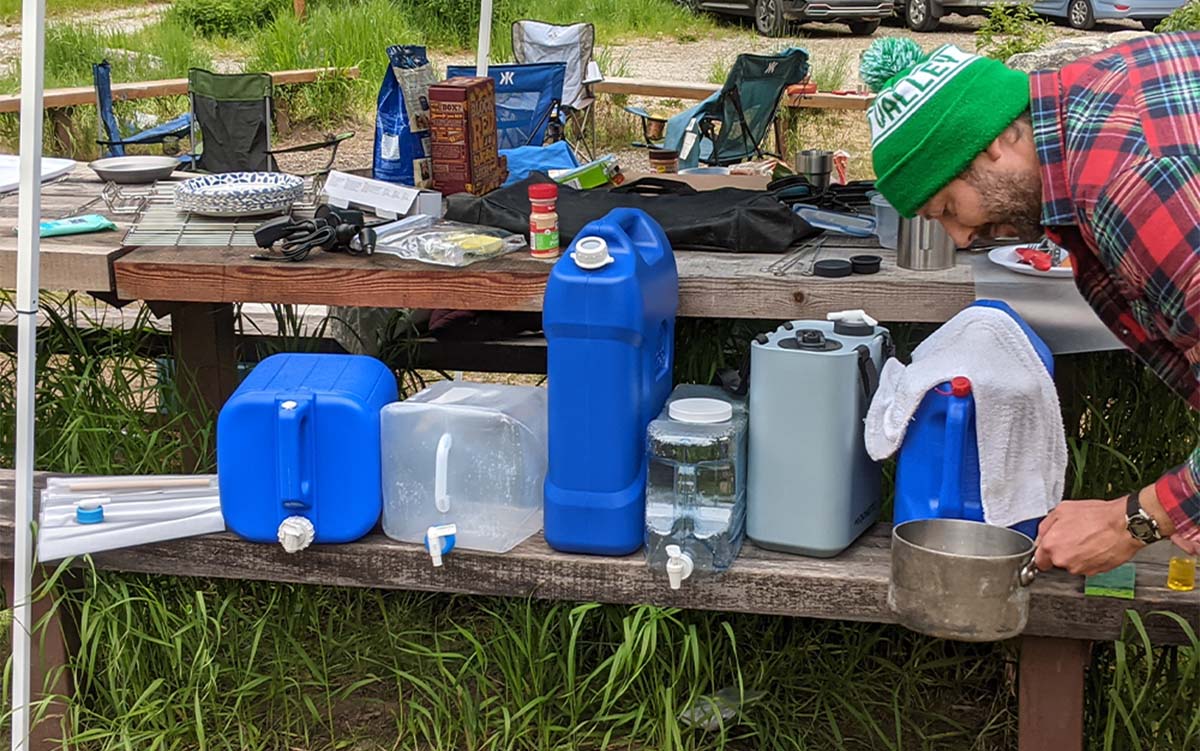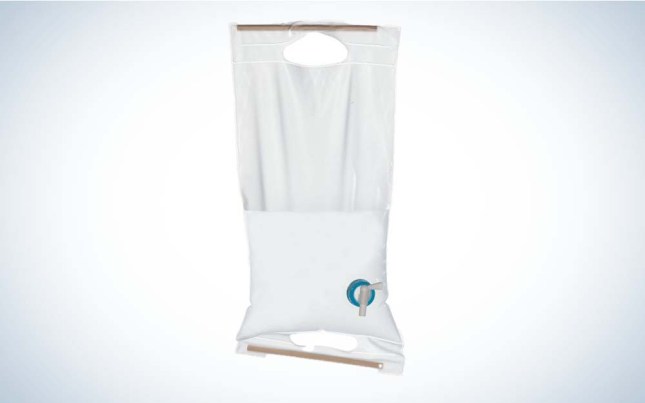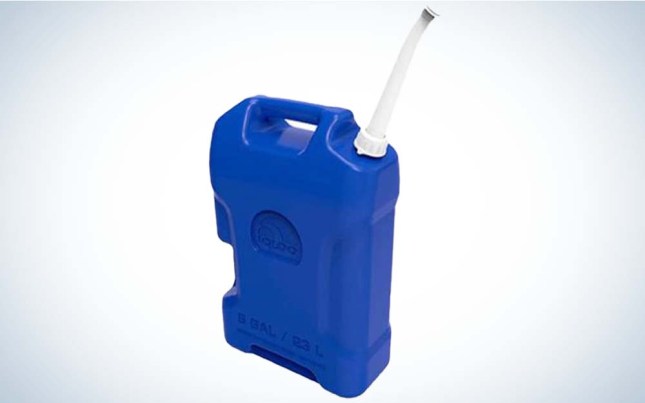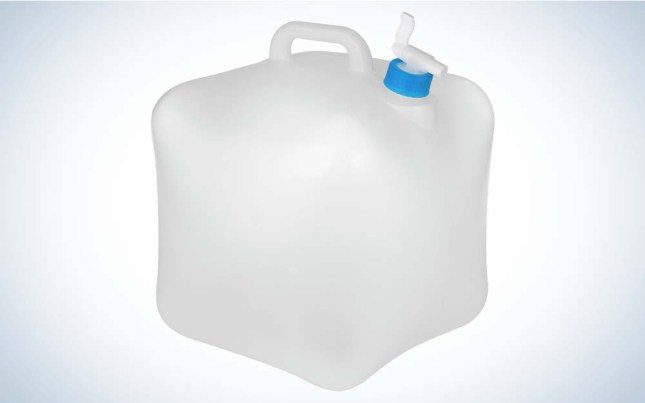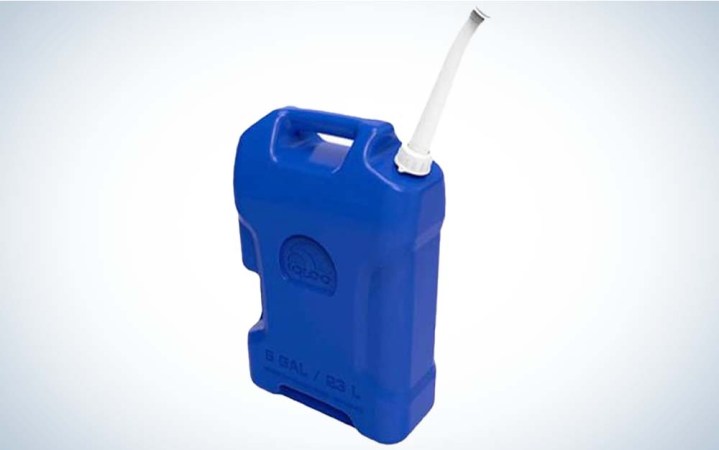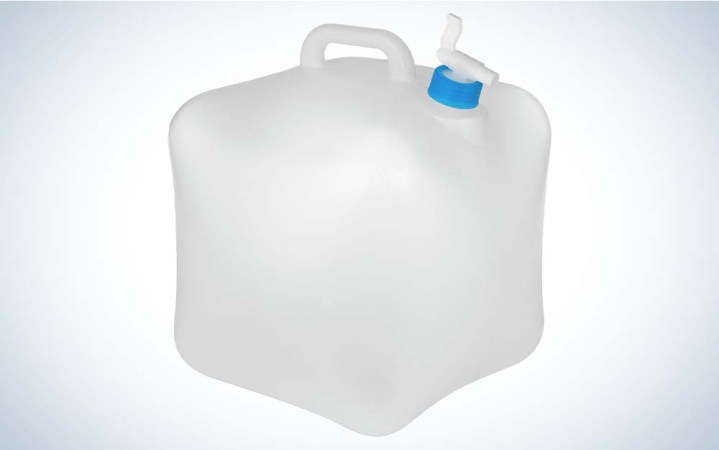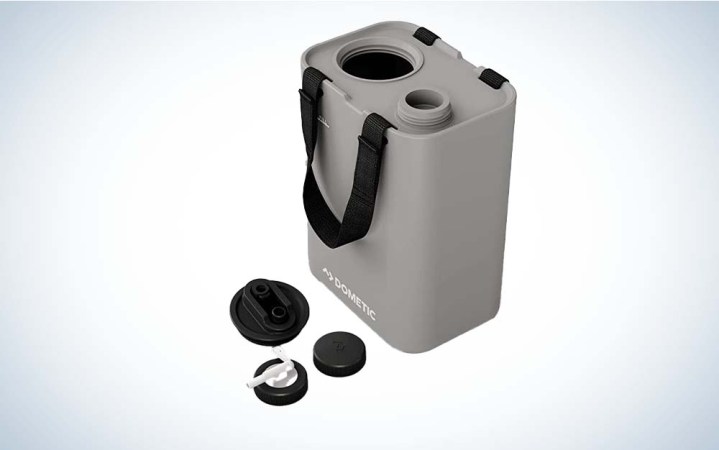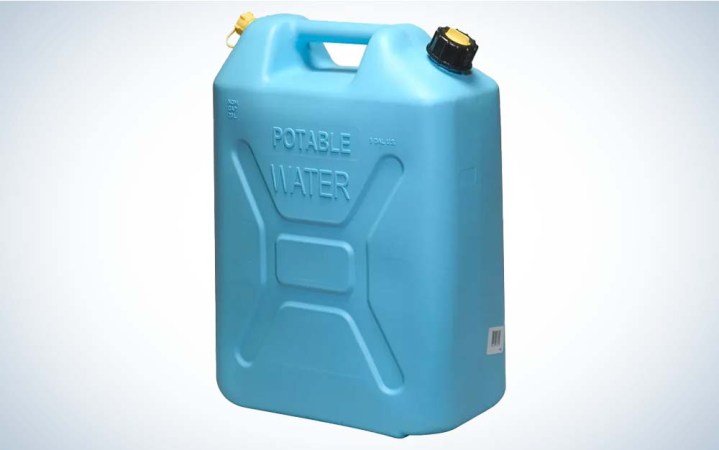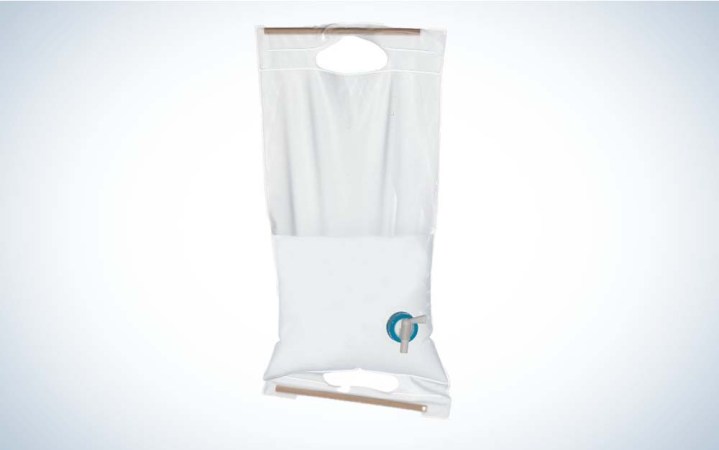We may earn revenue from the products available on this page and participate in affiliate programs. Learn More ›
If you’ve ever arrived at a campground with nothing but a nalgene bottle only to find that the nearest potable water is a quarter of a mile down the road, then the case for purchasing a camping water container will seem clear. But within the range of nearly identical blue-sided jugs and collapsible cubes there is a surprising amount of variability in function and materials. To help you choose the best camping water container for your next outdoor adventure, I checked out eight of the most popular models available:
- Best Overall: Igloo 6-Gallon Camping Water Container
- Best Collapsible: GSI Outdoors Folding Water Cube
- Most Versatile: Dometic GO Hydration Water Jug
- Most Durable: Scepter Military Water Container
- Best for Camping Boxes: UST Roll-Up Water Carrier 10L
Things to Consider Before Buying a Camping Water Container
Packed Size
While some car campers and overlanders are looking for a giant blue jug that can hold all the water they will need for the weekend, others will be carefully testrising everything into the back of their car along with sleeping bags and camping stoves, hoping they won’t have to leave their camping chairs at home for lack of space. Consider how much space you are willing to dedicate in your vehicle to your camping water container before committing to a purchase.
Durability
Typically, the thicker the plastic, the sturdier the camping water container will be and the longer it will last. The tradeoff for durability is almost always cost (with the exception of my best overall pick, the heavier duty camping water containers tended to be more expensive) and packed size, as the thicker the plastic is the less likely it is to collapse.
Spigot versus Tap versus Spout
Whether you choose a camping water container with a spigot or a spout is largely a matter of personal choice. With a tap, you must have one hand free to press down on the top lever, but very little water will be spilled out while in use—useful if you are camping somewhere where water is scarce. Spigots seem straightforward, but in practice some are much easier to use than others, (I had to brace one hand against the water container to get a spigot in my test to move) and the strength of their flow can vary. Spouts are the simplest mechanism, generally little more than an added tube or rubber insert that gives you greater control over how fast the water flows out of the camping water container when the lid is unscrewed.
Materials
Most camping water containers are made from plastic. As such, it’s worth checking to see whether your vessel is BPA free—and ideally also BPS and BPF free. Materials with BPA are used for food and beverages, and have been found to seep into the food or liquid that they contain. This is a concern for many, as BPA is known to negatively affect the brain and prostate glands of children, infants, and even fetuses. There may also be a connection with increased blood pressure, type 2 diabetes, and heart disease. There has been a push to eliminate BPAs in products used for food and beverages. Two compounds that are sometimes used instead of BPA are BPS (bisphenol S) and BPF (bisphenol F). While studies are still being conducted on the long-term effects of these compounds, there is concern that they may present health risks equal to, or even greater than, that of BPA.
Best Overall: Igloo 6-Gallon Camping Water Container
Key Features
- Capacity: 6 gallons
- Packed Size: 13.82 inches x 7.32 inches x 20.63 inches
- Materials: plastic
- BPA free
- Spout
- Two handles
Why It Made the Cut
The impressive capacity and easy-to-use spout of the affordably priced Igloo 6-Gallon Water Container is one that I reached for again and again.
Pros
- Large capacity
- Easy-to-use spout stores inside the container
- Durable
- Inexpensive
Cons
- No provided spigot or tap option
- Small top opening makes it harder to clean
Product Description
More than any other camping water container, I found myself reaching for the 6-gallon Igloo again and again during testing. Its double-handle design made it easy to lift and pour even when it was relatively full, and the spout (which would work well for RV campers) allowed me to control the direction and flow volume of the water. The only time I switched to using a different camping water container was when I needed to rinse my hands, as the lack of spigot or tap makes this impossible for one person to do single-handed.
While this wasn’t the most space-efficient option in my test, the vertical design made the Igloo Camping Water Container comparatively easy to squeeze into tight storage spaces (fortunately, it wasn’t so vertical so as to be tippy when half full of water). The slender build on this one also made it less awkward to carry from the campground water spigot back to my picnic table.
Best Collapsible: GSI Outdoors Folding Water Cube
Key Features
- Capacity: 2.6 gallons, 3.9 gallons, or 5.3 gallons
- Packed size: nine inches x nine inches x six inches
- Materials: Polyethylene
- BPA, BPS, and BPF free
- Spigot
- One handle
Why It Made the Cut
Even though the GSI Folding Cube doesn’t collapse back down as much as I’d like, it’s still a great space saver that is both inexpensive and BPA, BPS, and BPF free.
Pros
- Small packed profile
- Inexpensive
- Good water flow
- BPA, BPs, and BPF free
Cons
- Doesn’t collapse down flat
- Signs of stress where the plastic bends
Product Description
Fresh from their packaging, folding cubes always look so petite, their corners neatly bent and tucked. It’s like the camping water container version of origami. But don’t be fooled: your folding cube will never be that small again. (If you’re looking for a camping water container that will fit into your camping box, check out my best for camping boxes pick.)
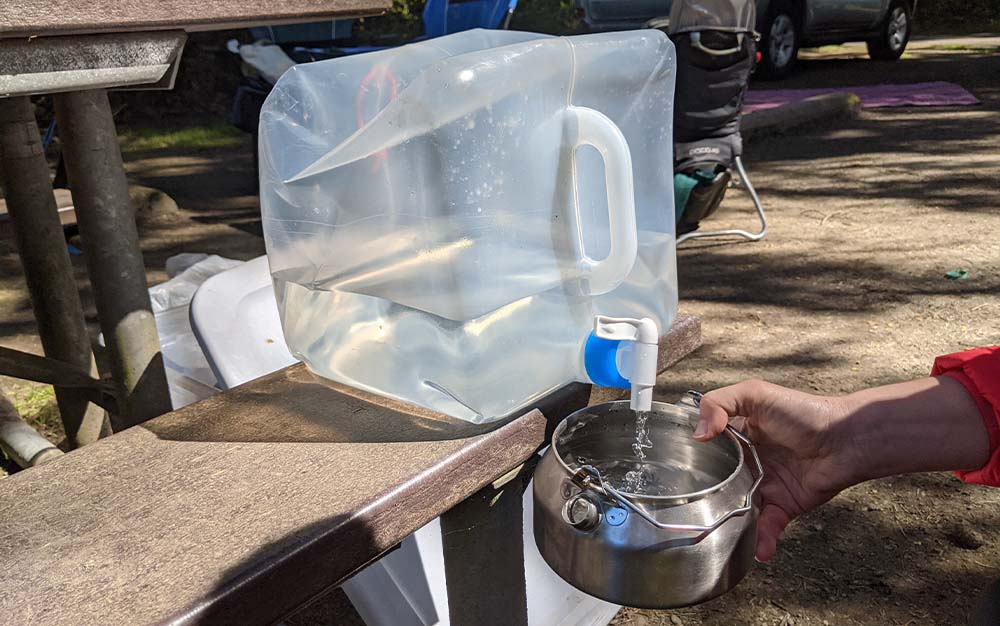
With that out of the way, there is a lot to like about the GSI Folding Cube. First off, it’s BPA, BPF, and BPS free. It also has good water flow, rapidly filling up my kettle without needing to release air from a separate tab. And while it doesn’t collapse down as much as it was straight out of the packaging, it’s easy enough to get this one down to a quarter of its size, saving plenty of room in your car and your gear closet for the rest of your camping supplies. Since this one is made from plastic that is meant to fold and crease, it will eventually wear out. While my GSI Folding Cube is still going strong after a couple of months of use, I can see creases from where it’s been bent, reformed, and rebent again.
Most Versatile: Dometic GO Hydration Water Jug
Key Features
- Capacity: 2.9 gallons
- Packed size: 10 inches x 14.5 inches x 7 inches
- Materials: LDPE plastic
- BPA free
- Includes a spout and spigot
- Two webbed handles
Why It Made the Cut
The easy-to-fill Dometic GO Hydration Water Jug was the only water container in my test that came with both a spout and a tap (as well as the option to purchase a compatible faucet).
Pros
- Two options for pouring out your water
- Easy to fill
- Webbed carry handles maximize your storage space
- Durable
Cons
- Awkward to carry
- Expensive (compatible water faucet is very expensive)
Product Description
Unlike other camping water containers in my test, the Dometic GO Hydration Water Jug provided two options for pouring water out: a spigot, which provides a slow, measured flow, and a soft-plastic flow reducer, so you can get a smooth but generous pour, which is useful for filling up pots for cooking.
The Dometic GO Hydration Water Jug is one of the best camping water containers for balancing storage size with capacity. If the big blue water containers seem like a bit of overkill for your camping setup, this is a great alternative. I also liked that it uses webbing for its handles, so that it minimizes the amount of space it takes up in your car or truck.
While there is the option to purchase the additional water faucet for the Dometic GO Hydration Water Jug, my experience is that the spigot is simple enough to use that there is no need for this additional accessory.
Most Durable: Scepter Military Water Container
Key Features
- Capacity: 5.2 gallons
- Packed size: 13.5 inches x 6.75 inches x 19 inches
- Materials: plastic
- BPA free
- Nozzle
- One handle
Why It Made the Cut
The plastic of the Specter water container was the thickest of any in my test.
Pros
- Very durable
- Easy to use cap
- Great water flow
Cons
- Very expensive
- Strong chemical smell when first removed from its packaging
- Lid leaks when on its side
Product Description
The Scepter Military Water Container was by far the sturdiest in my test. It’s still not as rigid as a metal container would be, but it’s getting awfully close while, at 4.5 pounds, still clocking in at a heck of a lot lighter. I liked that it had a large cap that was easy to position under a spigot, but also a smaller one to use back at camp for filling up water bottles or cooking pots. Above the smaller cap is a second screw that can be twisted off to improve water flow, but in practice this was difficult to use.
If you plan to fill the Scepter Military Water Container before hitting the road for your next car camping trip, be sure that it is stored vertically in your car, as the cap leaked during testing when stored horizontally. It’s also worth spending a bit of time cleaning out this water can before it’s first use, as it had the most significant chemical smell out of the box of any camping water container in my test.
Best for Camping Boxes: UST Roll-Up Water Carrier
Key Features
- Capacity: 2.7 gallons
- Packed size: 12 inches x 3 inches x 3 inches
- Materials: Polyurethane
- Spigot
- Two handles (on either side)
Why It Made the Cut
The affordably priced UST Roll-Up Water Carrier had the smallest packed size of any water container I tested.
Pros
- Very small packed size
- Inexpensive
Cons
- Difficult to fill up
- Spigot is positioned too high, making it difficult to extract all of the water
Product Description
When I first started camping, it was in a four-door sedan. Packing space was tight, so if I was going to bring anything more substantial than a nalgene, it had to fit in my camping box. That’s what the UST Roll-Up Water Carrier does, rolling up effortlessly without needing to crease the plastic material. This had the smallest packed size of anything I tried—about the size of a mostly used paper towel roll.
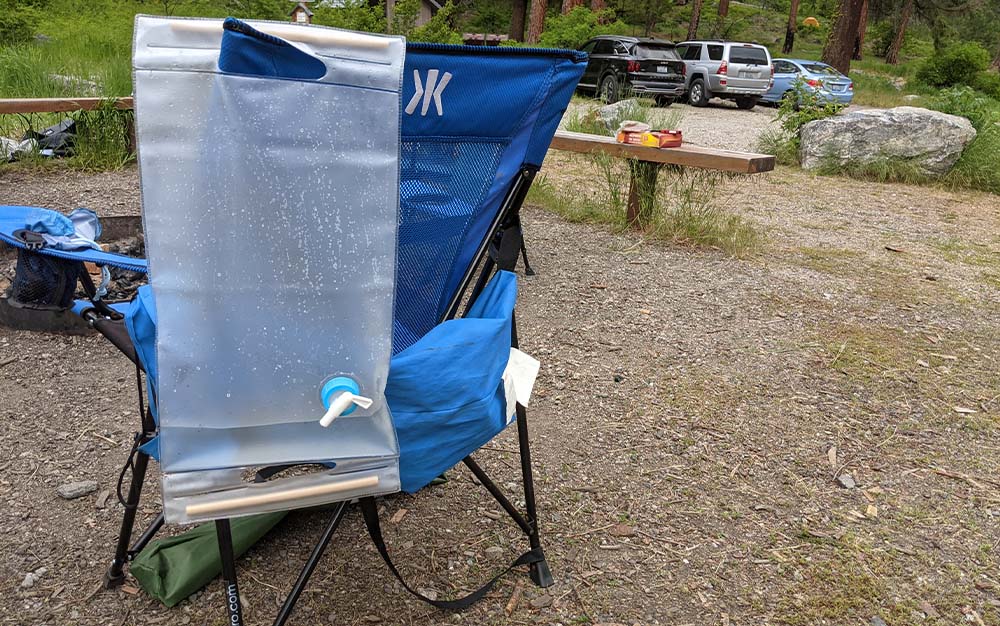
There are some drawbacks to the UST Roll-Up Water Carrier, however. First off, the same characteristics that make it easy to roll up also make it excessively difficult to fill, as the back of the water container must be pulled away from the front side to create space for the water to flow into the container. At one campground, where there was nothing other than an old-fashioned style water pump, it was impossible for a single person to fill it up. Next, you’ll need to bring along some rope or twine to tie this to a tree branch, as this is easiest to use when hung up, but the attached handles don’t lend themselves to hanging without additional reinforcement. Finally, the position of the spigot is high enough up the carrier that it’s difficult (although not impossible) to get the last liter or so of water out.
FAQs
Camping water containers typically cost between $10 and $80, depending on their size and the durability of the material used. That being said, there are many high-quality camping water containers available for less than $30, or even less than $20.
While you do not have to bring a camping water container if there is drinking water available at your campsite, it can be a helpful accessory. Growing up, my family’s water supply strategy while camping was to fill up a dozen nalgene bottles at one of the campground water spigots and then carry them all back to camp. This worked fine, even if it was annoying (I now use a camping water container). If you plan to camp somewhere where water will not be available, such as dispersed camping in the deserts of the Southwest, then a camping water container goes from being an accessory to being a necessity.
It’s a good idea to clean out your camping water container both when you first purchase it and at the start of each season, to ensure that no unwanted smells, mildew, or bacteria make their way into your drinking water. Per the Center for Disease Control, you should following the following steps to clean a camping water container: 1) wash the storage container and then rinse with water, 2) mix one teaspoon of unscented liquid household chlorine bleach in one quart of water and add add to your camping water container, 3) screw the lid back onto the open cap and shake the camping water container until the bleach solution has coated the inside of the container, 4) wait 30 seconds before pouring the bleach solution out of the camping water container, and 5) rinse the empty water container with tap water.
Methodology
In addition to considering price, capacity, and materials used, I tested camping water containers both at home and on a series of car camping trips, where they were evaluated on the following criteria:
- Packed size: I considered how easy, or difficult, it would be to fit each water container into a standard car camping vehicle.
- Ease of use: While camping I evaluated the camping water containers to see how easy they were to use for a variety of camp chores, including hand washing, water bottle filling, and washing dishes.
- Leakage: All water containers were filled, capped, and then left lying on they ground to ascertain whether they leaked.
- Portability: I filled the camping water containers to capacity and then walked a typical distance between a campground water faucet and a campsite (note that I did not evaluate whether a camping water container while full would be too heavy for an individual to use—a gallon of water weighs over 8 pounds so plan accordingly.)
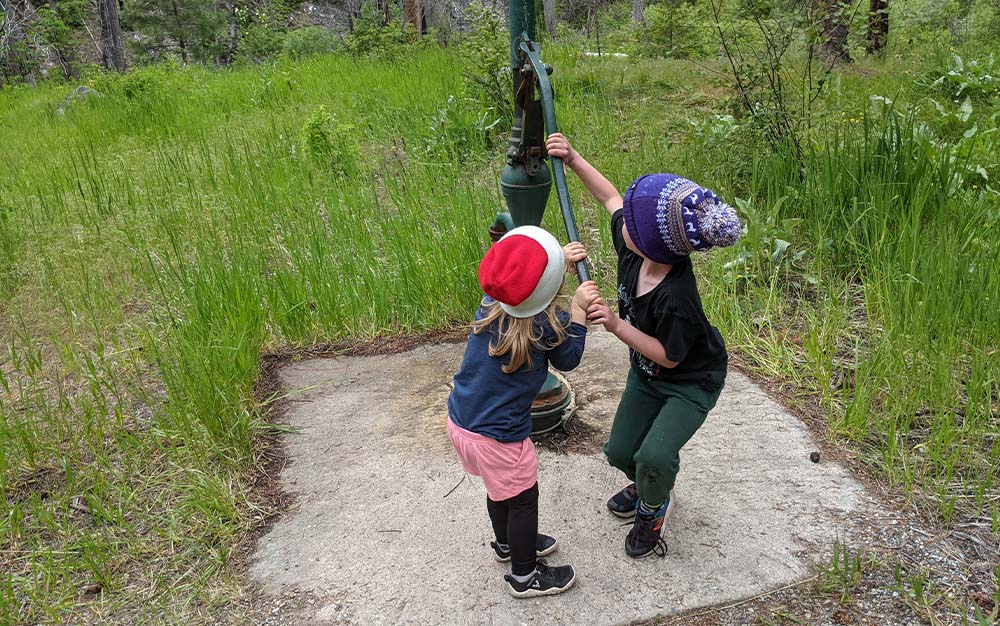
In addition to the above picks, I also tested the Coleman 5-Gallon Water Carrier, Reliance Jumbo-Tainer Water Container, and Arrow Home Products H2O Oasis Dispenser. The Coleman was both significantly more expensive than the comparable Igloo, and, due to its boxy size, harder to carry back to base after filling it up at the campground faucet. There were additionally a number of plastic shards leftover in the container from the manufacturing process, which was not the case for other camping water containers in my test. The Reliance Jumbo-Tainer came closer to the Igloo in performance, but the spigot was unusually difficult to use, making it less functional overall. While I was impressed with the functionality of the Arrow Oasis Dispenser, it neither collapsed down for easy storage nor was sufficiently durable for more than a season (at most) of use.
Final Thoughts
If you’re looking to upgrade your camping setup with one of the best camping water containers available, the Igloo 6-Gallon Camping Water Container is an excellent, easy-to-use choice that balances price with durability. If having a spigot is important, go with either the durable Dometic GO Hydration Water Jug or space-saving (and less expensive) GSI Outdoors Folding Water Cube. While the inexpensive UST Roll-Up Water Carrier didn’t impress me with its functionality, I was very impressed with its small size and low cost. If your sole concern is durability, then the comparatively expensive Scepter Military Water Container is the right pick for you.
